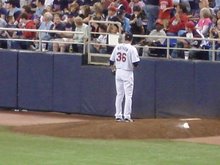Now that
Addressing these difficulties requires an honest assessment of the team’s stock in the majors and minors. Starting pitching is a position of strength, with an A+ ace at the top, an established, young member of the rotation in Bonser waiting on his first arbitration hearing, four big-time prospects who are either ready or close to ready to contribute (Baker, Perkins, Garza, Slowey), and a gaggle of prospects who would be far more distinguished in any other system that does not cast such a long shadow (Alexander Smit, Kyle Waldrop, Eduardo Morlan, Jay Rainville). On top of that group is a wildcard pitcher who outpitched Santana for long stretches last year, that being the absent Francisco Liriano.With pre-arb pitching prospects in vogue- as evidenced by the market value of recently-traded players like Brandon McCarthy and Jason Hirsch- that embarrassment of riches could help patch over lots of other organizational shortcomings if Terry Ryan chose to make a challenge trade or two. Additionally, the Twins have at least one position player who is ready to step into the lineup this minute in Alexi Casilla, who can do a pretty good Luis Castillo impersonation right now. Finally, one underrated resource is that the Twins grew a lot of their talent themselves, giving them additional leverage through arbitration or buying out those arbitration years in a long-term contract. In other words, the Twins will have several more years of players like Joe Mauer, Justin Morneau, Jason Kubel, Jason Bartlett, Mike Cuddyer, Boof Bonser, and Francisco Liriano at prices below market value.
At the moment, I see two moves that could dramatically improve the Twins for the next few years and would also decrease payroll. First, I still desperately want the Twins to address their third-base problem. Nick Punto has value as a utility player with some on-base skills and a very good glove. As an everyday corner infielder, his lack of power becomes extremely troublesome. Also, Jeff Cirillo is a fine option to spell lefties at DH or an infield corner, but the fact that his only listed position is “DH” hints at the trouble with playing him there everyday, not to mention the fact that he is extremely likely to break down if he continues playing so frequently.
To the Twins potential benefit, Edwin Encarnacion is a third baseman with some power who has fallen out of favor with the Wayne Krivsky’s Reds, a former Twins employee who has shown an affinity for collecting his former charges (Joe Mays, Juan Castro, Kyle Lohse, Eddie Guardado). Since the Reds were bearish enough on Encarnacion to sent him to AAA earlier this month, it does not seem unreasonable to think that he could be had for the right price. With
Playing off of their primary non-pitching resource, I believe it would be intelligent for the Twins to aggressively market Luis Castillo for another young bat. Casilla might not replace Castillo’s current hot-hitting, but he’s a better bet to be a productive member of the team after this season, and the difference between them for two or three months (Castillo is a free agent at season’s end) is not nearly great enough to make the difference between contending and falling out. With championship aspirations and a glaring hole at the keystone, the Mets would make a perfect trading partner for the Twins on the Castillo front. Even better, the Mets have a glut of young talent in the outfield, and not enough playing time to go around. With Omar Minaya’s affinity for Latino players, former top prospect Lastings Milledge has seemingly fallen out of organizational favor, sliding out of the outfield rotation. Even with Shawn Green breaking a bone in his foot, the team said it planned on giving the extra at bats to Carlos Gomez, leaving Milledge in
If the Twins made these trades, it would give them the ability to start a lineup looking something like this:
- Casilla- 2B
- Mauer- C
- Hunter- CF
- Morneau- 1B
- Cuddyer- RF
- Milledge- LF
- Kubel/Cirillo- DH
- Encarnacion- 3B
- Bartlett- SS
Factoring in Hunter’s possible departure (a fate of which I am not yet nearly convinced), putting Milledge in center makes it much easier to find a LF option within the system (Ford, Tyner, Kubel) or on the cheaper side of the free agent market- far easier than paying top dollar for someone with enough of a glove for center. The reason these trades appeal to me is that I think it strikes a balance between their interests for this year and the ability to compete going forward. Both players are cheap today and will remain cheap into the future. The players surrendered in the trades come from spots of organizational depth, lessening the impact of their departures. Addressing these issues now puts the team in a position to compete, just like last year when the Twins proactively addressed their weaknesses. While it is still early enough to make up a steep deficit within the division, enough time has already passed to see some problems clearly. Dealing with them now strikes the delicate balance patience and activity.

1 comment:
Brilliant. Very well done. Though I don't think the Mets are going to move Milledge for Castillo alone, perhaps with Castillo and a second level pitcher it could get done.
Also, you forgot to mention MY favorite Twins minor league pitcher (aren't there enough for everyone in the state to have their own person favorite?) Jeff Manship.
Post a Comment